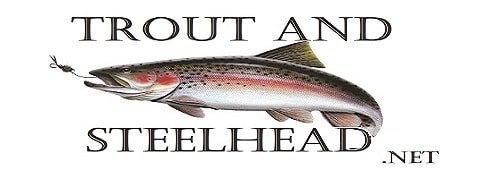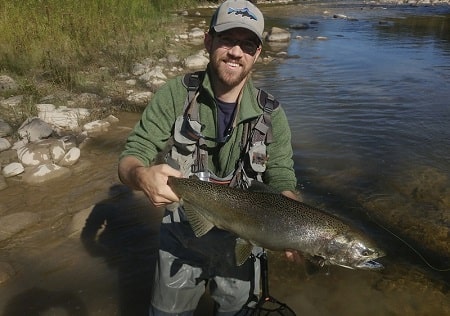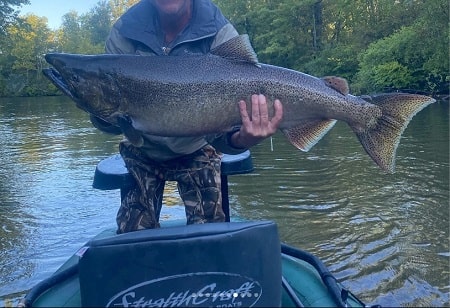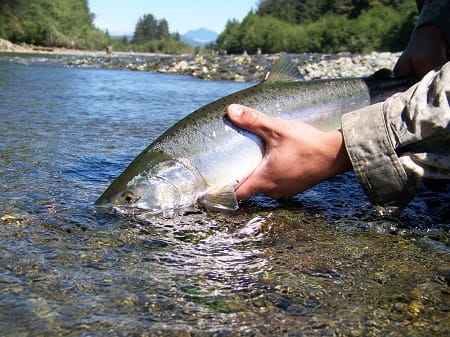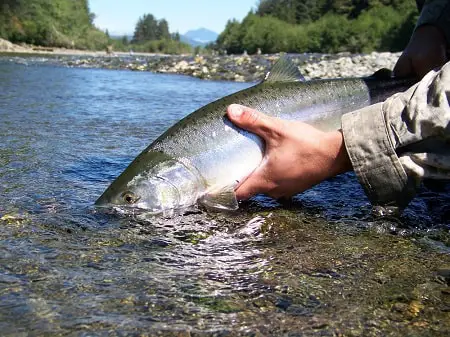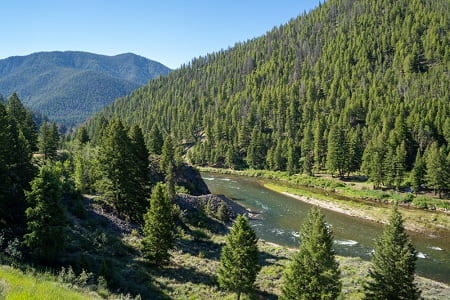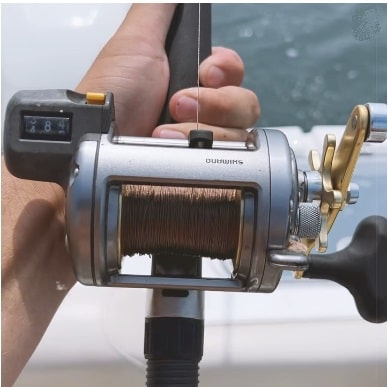Mooching For Salmon: A Complete Step-By-Step Guide
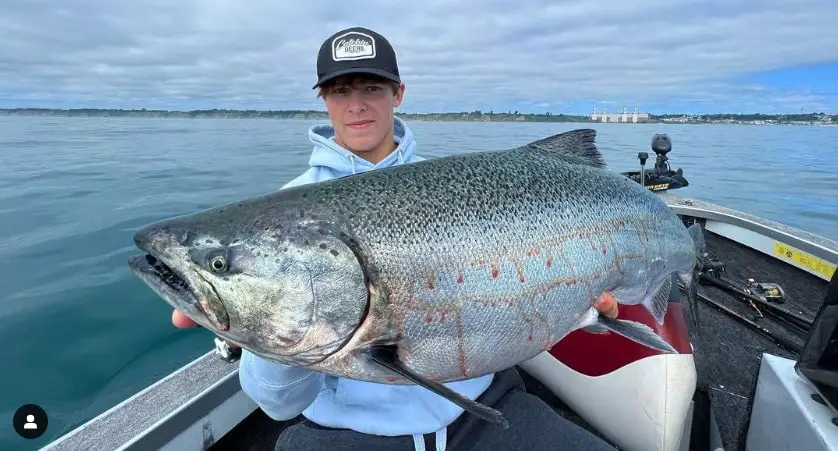
This is a step-by-step guide that covers everything you need to know about mooching for salmon, with all the information coming from experts.
To mooch for salmon, you’ll require the right gear, which includes a rod, reel, line, a mooching sinker, a two-hook leader, and a batch of herring for bait. Once you’ve got all the gear, it’s all about getting in the boat and going out to find a good spot, and then knowing how to mooch effectively.
Mooching is used for chinook and coho salmon fishing mostly, but you might catch pinks and chum with this method.
1. The Gear For Mooching Salmon
I mentioned all the gear you need to mooch for salmon, but let’s get more specific.
The Best Mooching Rod For Salmon
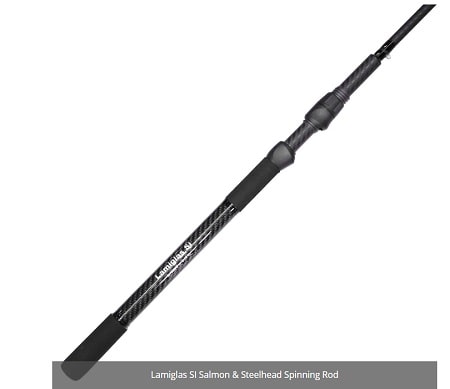
A longer rod is better for salmon mooching! I use a longer ten-foot rod with enough backbone in the lower rod to manage large king salmon, but one with a softer and sensitive rod tip to help detect bites.
Most anglers use eight to 10.5-foot medium-action rods for mooching. Although I could probably mooch for salmon with most general-purpose rods, or use the same rod I use to plug fish for salmon or do back trolling for salmon, I use and recommend a rod specifically made for mooching is best.
The rod line rating should be 10 to 20 on the light side, and 12 to 40 pounds on the heavy side for large king salmon.
Some rods to consider are:
- Shimano Compre 10′ 6″ MOOCHING ROD – Check Price – Best Deal
- G. Loomis E6X Salmon Mooching Rod – Designed specifically for mooching salmon.
- G. Loomis Salmon Series Mooching Rod – Designed specifically for salmon mooching.
- Okuma SST New Generation Spinning Rod – Budget Friendly, General Purpose, For Spinning Reels – Check Price
- Lamiglas SI Salmon & Steelhead Casting Rod – General-purpose salmon rod – Check Price
- Okuma Connoisseur Salmon & Steelhead Spinning Rod – Low Budget – Spinning Rod – Check Price
- G. Loomis Fiber-Blend Salmon Rod – Good all-purpose rod with sensitive tip – Check Price
- SHIMANO CLARUS MOOCHING ROD – Check Price
The Reel
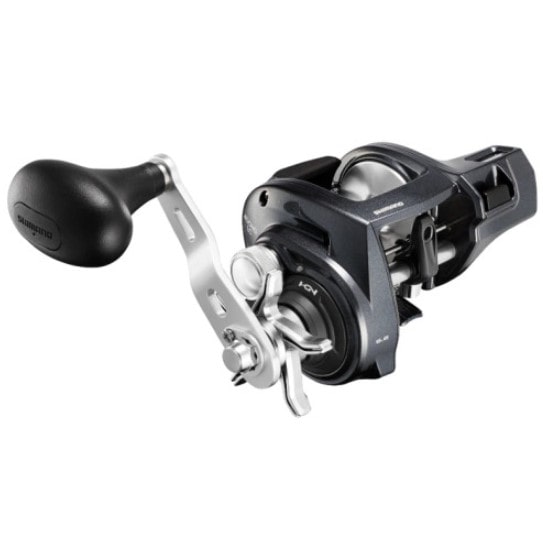
There are three types of reels that anglers and guides use for mooching salmon, but there is one reel that stands out as the best.
Spinning Reels – I could use a spinning reel for mooching, but it is not ideal.
Mooching Reels – Some anglers will also use a mooching reel.
Baitcasting Reels and Line Counter Reels – Baitcasting reels are also popular, but a level wind baitcasting reel with a built-in line counter is by far the best reel for mooching salmon.
When combined with a sonar unit that identifies how deep the baitfish and salmon are, with the line counter reel, I can drop my bait to the desired depth and keep it there the entire time. The longer my bait is in the zone, the more salmon I catch.
One of the best reels is the Shimano Tekota 500, but it’s a bit expensive, so see 11 Best Baitcasting Reels For Salmon.
The Line
Depending on who you talk to, there are two fishing lines commonly used to catch fish when mooching.
Monofilament Line: One of the best lines for this method is the monofilament line due to the extra stretch it has. The extra stretch or “give” of the line aids in hooking the salmon that peck away at the bait. A monofilament line is also easier to untangle than a braided line if the herring leader tangles on the drop.
High viz-green, yellow, or orange is preferred, and twenty to 30-pound mono line is best.
Braided Line: Some anglers and guides prefer a braided line because it is extra strong with a thin diameter. I often use a 65-pound braid with a 25 to 40-pound fluorocarbon leader.
The Leader
Mooching Leader Pound: Most anglers and guides are using fluorocarbon leaders in the 25 to 40-pound range. On finicky salmon, I use a lighter leader. When the bite is hot, I will use a 40-pound leader so I don’t have to re-tie as often, I get the fish in faster, and get back to fishing sooner, which means more fish caught.
Mono Leaded: Other anglers say that the best mooching leaders are made with 20# to 30# clear monofilament.
Mooching Leader Length: When using a shorter or of 8 or 9 feet, use a 5 to 6-foot leader. When using longer leaders, some anglers prefer a longer 7 or 8 leader.
Leader Rig and Hooks: The Leader rig consists of 2 single hooks about 3 inches apart. The preferred hook for big fish is the Gamakatsu Octopus hook in size 2/0, 3/0, or 4/0.
Some anglers will run a larger front hook on the top and a smaller trailing hook size at the back.
You can buy pre-tied mooching leaders HERE.
Be sure the area you fish permits you to use two hooks. In some areas, barbless hooks are required, so check the fishing regulations before fishing.
Mooching Sinker: The mooching sinker is often called a kidney sinker because it is crescent-shaped. Most of them have a bead chain and swivel for attaching lines and leaders. A 4-ounce sinker is good for most mooching situations. A 6-ounce sinker is used occasionally for strong wind conditions.
Net and Release Gear: I always have a good salmon-sized net with a long handle. It’s also important to have handling gloves and long needle-nose pliers to get the hooks out.
A rag for cleaning and drying my hands is a nice option.
The Boat
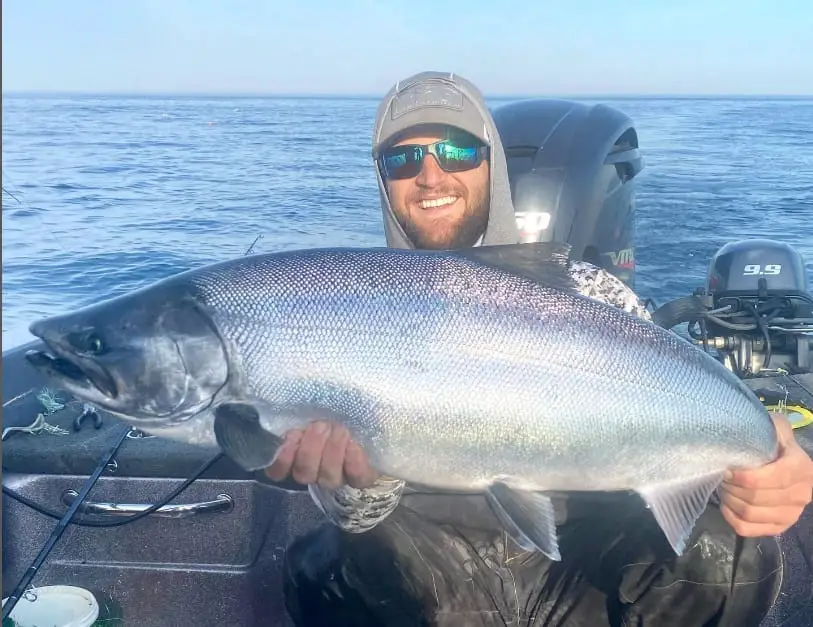
Any sized boat is suitable as long as the water is calm. Most prefer at least a 16-foot motorboat for mooching. The motor aids in getting a good boat drift, especially on calm days and in sheltered marine areas.
A bow mount trolling motor is also a good option to keep the boat moving at a steady and controlled speed.
Sonar, GPS, and Fish Finder
A sonar fish finder unit with a built-in GPS is a tool that is hard to go without. The combo of GPS and sonar helps locate the fish and relocate spots with fish. If I drift off a spot while fighting a big king salmon, the GPS can help me get back to the exact spot.
It can also aid in a safe return to port should I get lost or get stuck out in the fog. Trust me, there have been days when I would have been in trouble had I not had my GPS.
The sonar unit will help locate the bait as well, which shows me the exact depth to catch fish.
2. Preparing And Rigging Cut Baits Properly
The bait used for mooching is known as a cut plug herring, which, when reeled in becomes a spinning bait. A cut plug herring is simply a herring with its head cut off. Ensure the herring is cut at about a 35 to 45-degree angle from one side to the other.
This plug-cut herring will roll or spin when pulled up or when dropped. Most anglers will also pull the guts out so the herring is hollow.
See the video: How to rig a Cut Plug Herring for Salmon Fishing.
Guide Tip: Before I drop a new cut plug herring down, I test it in the water by pulling it sideways beside the boat with the rod to ensure it has a nice spin.
Pre-packaged frozen herring is usually sold in trays and comes in various sizes. The size classifications are often indicated by the color of the label. The goal is to use bait that mimics the natural food the salmon in the area are feeding on.
In Washington State, near Puget Sound and the San Juan Islands, the Green Label herring tends to be both popular and widely available.
For those targeting Coho and Chinook salmon in Puget Sound, Red or Green Label sizes are commonly used. When fishing out in the open ocean, the Blue Label size is often considered optimal.
Herring Information
| Herring Label Color | Herring Size Range | Leader Hook Size |
|---|---|---|
| Orange | 3″ to 4″ | 2/0 – 1/0 |
| Red | 4″ to 5″ | 3/0 – 2/0 |
| Green | 5″ to 6″ | 4/0 – 3/0 |
| Blue | 6″ to 7″ | 5/0 – 4/0 |
| Purple | 7″ to 8″ | 7/0 – 6/0 |
| Black | 9″ to 10″ | 8/0 – 7/0 |
Pro Tip: Buy the packages that have the most scales intact. More scales increase flash, which attracts more salmon. Thawing them slowly and brining the herring makes it stiffer and more durable, so it will fish longer.
Salt water brine is good, or check out Pro-Cure Brine N Bite.
Herring Home Brine Option:
- 5 cups of distilled or spring water
- 3/4 cup of natural sea salt
- 3.5 tablespoons of powdered milk
- 2.5 tablespoons borax
I mix it all together and I place as many herrings as I think I need, or can fit in the container. Store in fridge or cooler overnight
Hooks: One hook goes into the top part of the cut plug herring, and the other hook goes into the belly area.
Cutting Board and Sharp Knife: Unless I cut and prep all my plug-cut herring at home, having a cutting board and sharp knife onboard is a good idea. Even if I prep my cut plug at home, my knife can make the necessary alterations to get the cut herring size right and make it spin properly. Also, get yourself a good pair of cutting gloves like these.
I also ensure I have plenty of baits for everyone on board, and in case the fishing is hot and I go through a lot of baits fast.
3. When and Where to Find The Salmon
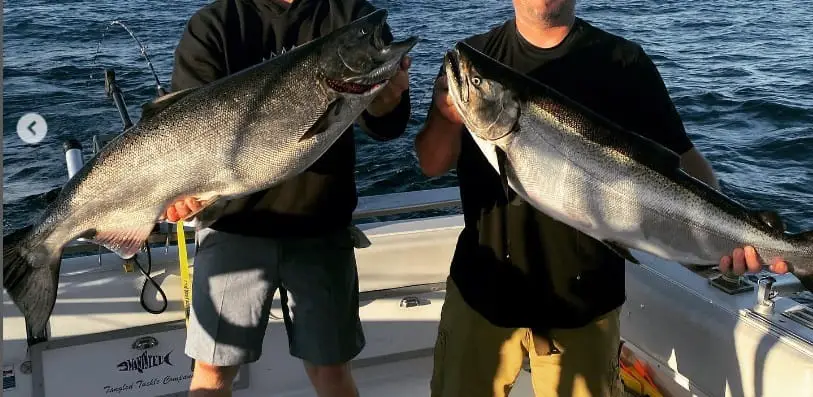
These are a couple of tips to help anglers catch more salmon consistently, and finding the baitfish is the key.
Fish Where The Boats Are: The quickest way to find the salmon is to follow the boats! Look to see where the other boats are fishing, especially the charter boats and other moochers. Chances are, they found the salmon or they know where the fish are, so go fish where they are. But be courteous, and stay out of their way if they are trolling.
Use the Sonar: Once I locate this area, either drive around looking for baitfish on the sonar. Fish on top of the bait as much as possible.
Set Up The Drift: Stop the boat upwind, or up-current of the spot I want to fish, and start the boat drifting naturally. With no wind or no current, use the motor mooching method mentioned below.
Pro Tip: The boat will naturally turn broadside to the wind. I want to face the wind and fish out of the windy side of the boat so my line is not directly below the boat, and so the line is always on a slight angle at all times.
Fish The Right Depth: Keep a close eye on the sonar unit to determine where in the water column the salmon or their bait is located.
During the summer months, the salmon may be out further and might be deeper, but closer to their migration runs, the salmon may be closer to shore, near kelp beds, or out from river mouths, and they might be in shallower water.
Watch The Tide and Currents:
Schools of Coho can be spread out, but Chinook prefer structure and currents. Both will concentrate in areas where the bait is stacked up. Look for tide rips and deeper underwater structures.
Tide Flood: Pay attention to the tide charts. During flood tide, the bait will get pushed up onto the structure, so fish that side of the structure. As the tide continues, the bait will get pushed up on top of the structure and often get pushed over the structure. Learn to follow the bait up and over, and fish on top of the bait at all times.
Tide Ebb: As the tide moves back out, the baitfish will slide up and over the structure again, but this time from the opposite side. Follow the bait up and over the structure.
Learning how to do this keeps me on the fish.
4. The Drop
Once I am all rigged and on the fishing grounds, it’s time to get the bait down to the fish. Don’t drop the hearing and weight straight down, or the hearing will tangle on the line as it spins on the drop. The boat must be moving with the motor, the wind, or current.
Control the speed of the descent with gentle thumb pressure to eliminate the chance of tangling.
I watch the line angle before I drop the plug-cut herring. If the line is straight down, I risk the herring spinning and tangling on the mainline.
If the rig is straight down, I start the motor to move the boat to change the line angle to a better angle.
No Wind Drop: When there is no wind, use the motor to move the boat and change the angle of the line.
Light Wind and Light Current Drop: With a light wind or light current, lower the bait slower with more thumb pressure to prevent the herring from tangling on the line and to prevent the line from tangling on the spool. Some guide will hand-pull out the first 25 feet
Strong Wind Drop: A strong wind poses the problem of not getting the bait down fast enough. I will use a wind sock to help slow the boat down. I may also upsize to a 6-ounce weight.
5. The Retrieve
The key to the retrieve is to keep the herring spinning, which means I want to start the retrieve the second I have reached the desired depth.
Keep a nice steady reeling retrieve. I don’t reel fast to catch salmon. This is a slow fishing method, so be patient.
If this is your first time, practice by dropping the herring down ten feet and reel it up a few times until you get the right spin. Then remember how fast you are reeling.
Chinook salmon prefer a slower retrieve, but coho salmon will hit a fast-moving bait.
Pro Tip: The salmon will hit on both the drop and retrieve, so pay close attention to feel a pite or unusual pulling, especially on the drop.
6. The Bite And The Hook Set
The bite is often a subtle tug or a tug-tug-tug. If I get a bite, I don’t set the hook right away. Instead, I start to reel fast until the rod bends over and the salmon starts to run, I set the hook when I feel the weight and pull.
If I don’t get that hard rod bend pull, the salmon may have released the bait, but it could come back and bite again. If this is the case, I just keep reeling steadily until I feel the salmon pulling hard.
When the salmon is on, don’t pump the rod, don’t give them slack, and just keep reeling. If the fish swims towards me, I reel fast until I feel the weight of the salmon.
7. Netting The Fish
I am running five to eight-foot leaders, and there are two common methods to net the salmon beside the boat more effectively.
Many guides will tell you to reel all the way in until the leader hits the rod tip and then step backward to bring the salmon close to the side of the boat so the net man can net the fish. This works very well.
I prefer to reel the fish in until there is a full rod length of line, which saves my rod tips from being damaged, and then tilt the rod sideways or upwards to drag the fish to the side of the boat where it can be netted. This has worked effectively for fish over 50 pounds for me and my clients.
Be sure you have a good salmon-sized net. I’ll show you the best at: 7 Best Salmon Nets: For Boat, Bank And River Fishing
8. Motor Mooching Method For Salmon
Big king salmon and coho are not always out in the ocean where the current and wind drifts the boat. Sometimes, the big salmon will be in shallower water or closer to shore where they will feed amongst the rocks and kelp beds. This water has less current and less wind, so to keep the boat moving at a nice, slow speed, use the motor mooching method.
This involves starting the main motor at trolling speed while I drop my bait so it does not tangle. Once the boat is moving at a slow speed that changes the line angle, turn off the motor or leave it in idle. Repeat this process when the boat slows too much or stops or each time I drop the bait down.
I try to keep the same speed as the current or wind would push my boat.
Motor mooching keeps me from tangling the bait and lets me cover more water when fishing in-shore waters where it is calm. Motor mooching can be done anywhere and at any time I need boat movement to fish effectively.
Tight Lines
Graham
